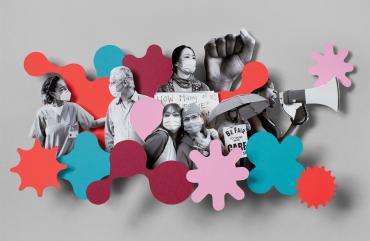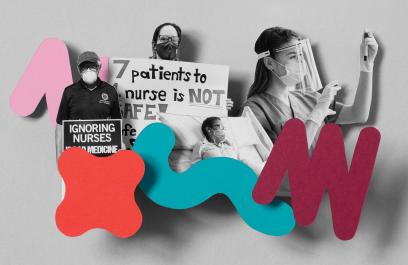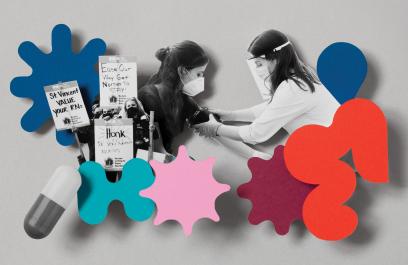Shanon Pereira had taken every precaution to keep herself and her family safe from COVID-19—but as a nurse at Backus Hospital, where the supply of personal protective equipment (PPE) was so inadequate that she had to reuse an N95 mask that she stored in a paper bag, it felt like it was only a matter of time. “Reusing PPE until it’s broken or visibly soiled is the reason that my family and my coworkers became ill,” she said. “We deserve safety, protection, and respect.”
Instead, Pereira got blame. Backus Hospital insisted that the repeated COVID-19 outbreaks among staff were due to lapses in proper use of PPE. It was only the latest in a series of cascading issues that compromised staff safety and patient care in the years since Backus was bought by Hartford HealthCare and hospital priorities shifted from patients to profits (or surpluses, as profits are euphemistically known in the nonprofit sector). This outsize focus on the bottom line meant that wages were dramatically lower than at neighboring hospitals—14 to 16 percent on average—which made it difficult to hire or retain nurses. The resulting chronic staffing shortages left nurses overworked, exhausted, and struggling to care for their patients. Even with these problems and the additional strain of the pandemic, the employer had been dragging its feet at the bargaining table for months, leaving nurses working without a contract.
In October 2020, the Backus Federation of Nurses (AFT Local 5149) went on strike for 48 hours. Just over a week later, they had a new contract with significant pay increases and better workplace protections, which they expect will help with staff retention and patient safety. “We choose to strike only when it becomes a life-or-death situation for our patients,” Pereira said. “I would rather be at the bedside … caring for my patients, … but we cannot allow unfair labor practices to continue. We will not back down when it comes to protecting safe patient care.”1
Healthcare workers like Shanon Pereira have always been our leading experts on the strengths and weaknesses of our healthcare system. For decades, they have sounded the alarm about their struggle to provide patients with the care they need because of the inappropriate distribution of resources and the perverse incentives built into the entire system.2
The COVID-19 pandemic has demonstrated that our healthcare system is not fit for protecting public health. We have seen clearly that the system was not built for pandemics, but a larger and more essential point has also emerged: the system was not built to provide needed healthcare to all of us or to improve the health of our society as a whole. Rather, our fragmented, profit-driven healthcare system allocates care on the basis of the patient’s ability to pay (or the system’s ability to profit) and depends on healthcare workers who consistently endure high levels of stress from striving to provide adequate care in the face of dire need.*
Nurses working through the pandemic have experienced unimaginable hardships. They have faced high patient mortality rates and have endured mental and physical exhaustion as they race to respond to all patient needs. They have risked their own health and the health of their family members, and they have worked in hospitals and nursing homes that initially had insufficient supplies of PPE. The mortality of healthcare workers due to the pandemic has been high,3 with death rates amplifying other societal inequities; for example, the large number of deaths of Filipino nurses demonstrates the cumulative impact of structural disadvantages for immigrant workers of color in a system that perpetuates health inequities.†
For nurses and other health professionals who had been drawing attention to insufficient staffing levels for years, the pandemic proved yet again that they were right in focusing on the link between staffing levels and patient care—but being right provides cold comfort. The experience of the pandemic has confirmed that the needs of patients are firmly aligned with the needs of healthcare workers: what’s good for one is good for the other.
For years, the immense challenges to nurses and the crises in morale and job tenure have been categorized by observers as burnout. This description, however, elides the longstanding systemic problems in nursing and in healthcare organizations. Among other issues, the shifts in hospital management policies toward lower staffing levels, higher patient loads, and stagnant wages make it nearly impossible for nurses to provide adequate patient care; ultimately, these shifts may drive as many as 40 percent of nurses away from the profession.4 And yet, we have known for 20 years that sufficient staffing alleviates this “burnout” while also improving clinical outcomes.5 Sufficient staffing levels may even have a more significant positive impact on job satisfaction and tenure than pay.6
More recent analyses have recast the problem of burnout, which occurs on an individual level, as moral injury, the complex psychological and emotional harm that results from working in a system that makes it so difficult to provide the needed level of care to patients.7 In unsupportive environments, the strain of the moral injury becomes a self-reinforcing, vicious circle. Nurses feel unable to fully care for their patients, in part due to low staffing levels, and their confidence in their employers and their affinity for their own workplaces diminish. To meet minimum staffing requirements, hospitals are spending more and more on travel nurses (as travel nurse agencies make a profit for every hour their nurses work) and have less money remaining to pay their committed nurses.8 As stable, permanent nurses are replaced with travel nurses, the strain on the remaining permanent nurses becomes more severe; they are tasked with training the newcomers to their workplaces, all while knowing that these newcomers are taking home much higher wages. As the work environment deteriorates further and the wage disparity becomes more extreme, the temptation to take a more lucrative contract or a travel nursing job—or to leave the profession entirely for something less stressful—only increases. In this vicious circle, some immediate patient care challenges may be met, but the long-term, systemic problems that cause harm to nursing staff and affect their ability to provide care remain.
It’s no surprise to nurses that hiring and deploying more staff improves patient care and in turn prevents moral injury—or that healthcare workers’ firsthand knowledge of systemic problems affecting the day-to-day work of patient care makes them uniquely qualified to devise solutions. But what may surprise many healthcare workers is that they have the power to fight back. How? By organizing. As Patricia Pittman put it in the Spring 2021 issue of AFT Health Care, “Nurses, along with other healthcare providers, need to elevate the discussion of moral injury to a system-level conversation about solutions. Until the major sources of moral injury are addressed across many different practice settings, a large segment of the nurse workforce will continue seeking to reduce their work hours and even leaving the profession as soon as they can.”9 While leaving the profession is understandable in the face of these challenges, growing the union movement in healthcare offers a better path forward—one that allows patients and workers to have the care and conditions they deserve. In the terms of classic industrial relations research, workers can choose voice rather than exit if they stay and organize to improve their workplaces. Collective action has the power to address the sources of moral injury both individually and at the system level.
The Union Advantage for Patients
Healthcare unions have always served a dual purpose, advocating for the ability to provide the care that patients need while also providing crucial protections for employees. Even so-called bread-and-butter issues like pay and benefits are directly linked to patient care: when nurses and other healthcare workers cannot afford to remain in their jobs, or when low pay leads to recruitment challenges and insufficient staffing, patient care suffers.10 In contrast, a workplace that provides a supportive environment also enables these workers to provide the care their patients deserve. Unions ensure a safe voice on the job so that workers can speak up when they notice a problem without fear of retaliation. Unionized workers tend to stay in their jobs longer, and lower turnover means more experienced nurses are at the bedside every day caring for patients.11 So, it should come as no surprise that a growing body of research demonstrates that the presence of a union improves the quality of patient care.
Just as it’s possible to rigorously evaluate the impact of medication and other clinical interventions on patient health outcomes, it is possible to look at the link between organizational factors and patient outcomes.12 We know, for example, that better work-life balance for workers can lead to better outcomes for patients.13 And we also know a great deal about the empirical effects of unionized workers on clinical care, as directly compared with patient care outcomes in nonunion workplaces.
A foundational study examined the link between the presence of a union for nurses and a patient’s likelihood of surviving a heart attack. The authors found that the presence of a union increases wages for nurses, which had a positive impact on patient care.14 And, after rigorously examining other possible explanations and confounding variables, they concluded that registered nurse unionization reduced heart attack mortality by 5.5 percent.15
A more recent study looked at multiple clinical outcomes and compared similar hospitals—those with successful and unsuccessful union organizing drives—to analyze the specific ways nurses can have an impact on patients. It found an improvement in the quality of care following unionization. Accounting for the fact that poor patient outcomes may lead nurses to organize a union in the first place, the researchers concluded that “hospitals with successful union elections in California during the 1990s and early 2000s had been experiencing declines in patient health outcomes relative to the average hospital prior to the election. But following the election, hospitals with union victories performed better relative to those in which the union lost.”16
In examining the difference between COVID-19 mortality rates in nursing homes in New York state, another study showed that residents of unionized nursing homes were less likely to die during the pandemic. Facilities with unionized staff saw mortality rates that were 1.29 percentage points lower, which amounted to “a 30 percent relative decrease in the COVID-19 mortality rate compared with facilities without these unions.”17
Taken together, these studies should assuage any concerns that unionized workers prioritize their own needs and interests at the expense of the needs of their patients. It’s clear from this growing body of research that unionizing is good for both healthcare workers and patients.
But even in the face of this clear evidence, many employers pump a huge amount of money into stopping their employees from unionizing and, when there is a union, attempt to negotiate contracts that do not prioritize resources for quality patient care. Strong worker voice threatens management’s ability to impose unilateral policy changes that protect the bottom line at the expense of both patients and staff. To fight this profiteering, healthcare workers must band together to achieve systemic changes that prioritize patients.
Organizing for System-Level Change
By protecting individual professionals through the enforcement of contractual rights, unions allow nurses and other healthcare workers to exercise professional judgment and provide patients with the care they need. But individual protections cannot bring about systemic change. Through strategic use of their collective power, unionized healthcare workers can bring about broader changes in their workplaces and can also work to transform or at least improve the larger healthcare system. While it is never easy, collective action is the only path to bringing about these changes in the face of powerful, well-funded opposition. And it is the only true solution: frontline workers—not administrators, lobbyists, or policymakers—have the experience, insights, and expertise to understand where and how these systems must change in order to better serve their patients.18
Unionized workers have three main types of collective action in the fight for systemic change: bargaining (and sometimes striking) to achieve strong contracts; enforcing the contract by using the grievance procedure; and advocating and mobilizing to achieve legislative changes that may improve all workplaces, not only unionized workplaces.
Each action has strengths and weaknesses. When used together, each of the three can complement and reinforce each other, offering alternative routes to realizing improvements. For example, a strong contract is powerful—in practice it can provide a policy that is more enforceable than a state or federal law because using a contractual grievance procedure doesn’t depend on a public agency that may be under-resourced or penalties that may be too weak to act as a deterrent. But bargaining is also limited in its impact; it means achieving improvements one employer at a time, and healthcare workers and patients in nonunionized hospitals do not receive the benefit of these improvements. By advocating for legislation, nurses can use their expertise, their collective strength, and the power of broader alliances and relationships to bring about improvements that reach every healthcare workplace and every patient.
In general, it is most effective when unionized healthcare workers engage in multiple kinds of collective action, as they are mutually reinforcing and require the same kind of organizing. For example, successful bargaining requires smart, long-term organizing in order to build sufficient power to win the contracts patients and workers need. In many cases, this means a willingness to strike—but a strike does not come out of nowhere. Workers must be well prepared to walk off the job on behalf of their patients and their coworkers. Successful strikes often require years of organizing and groundwork, with workers exercising power at the bargaining table before contemplating a strike. Healthcare workers can test strike readiness by embarking on a series of escalating actions through which fellow union members demonstrate their willingness to take a public stand in service of their goals. These actions might include signing public petitions, posting their views on social media, reaching out to community members and elected officials, participating in rallies, and/or attending public or open bargaining sessions. All of these actions enhance the union’s bargaining position—and can amplify its advocacy initiatives. They also send strong signals to administrators and legislators: If healthcare workers remain unified as their actions escalate, then they are well organized and prepared for a long fight at the bargaining table, on the streets in a strike, or in the legislature. But if workers do not feel able to participate in smaller-scale collective action, they are unlikely to stay out of work for an uncertain period or to engage in sustained advocacy.
The three paths to improvement—bargaining, enforcing the contract, and advocating and mobilizing—can work as complements. No one path solves all the problems in any healthcare workplace, let alone all workplaces. But the collective strength of unionized workers provides a crucial resource for using all three paths to achieve sustainable, systemic improvements to patient care.
Organizing for Safe Needles: A Case Study
Healthcare workers frequently feel frustrated and demoralized, and they may feel that the obstacles to providing the care their patients deserve are truly insurmountable. But collective action can create the confidence to build power and create positive change. The fight for safe needles is a perfect example.19
When Peggy Ferro, a nurse’s aide in San Francisco, contracted HIV through a needlestick injury, the nurses she worked with knew that if her employer had been willing to pay for safer retractable needles rather than cheaper conventional needles, she would not have contracted this bloodborne disease. Employers were not spending money on these safer devices because they did not have to do so. Ferro testified before Congress about her situation in 1992. She died of HIV in 1998 at just 49 years old.
Ferro’s story—and far too many others’ stories of HIV and hepatitis—spurred Lorraine Thiebaud, a nurse and member of the Service Employees International Union (SEIU), to devote a decade to fighting for safer needles. To succeed, she engaged in all three types of collective action: contract enforcement, bargaining, and advocacy.
Thiebaud began her campaign for safer needles by using the grievance procedure in her contract, along with a workplace campaign consisting of a petition, public posters, and public demonstrations. Working with the other unions in her hospital, she and her colleagues eventually won the right to retractable needles in their San Francisco hospital. After achieving this important change, Thiebaud and others pushed to ensure that the same protections were covered in other union contracts throughout area hospitals and clinics.
While Thiebaud’s strategies were successful in her workplace and in others with strong unions, they did not reach the large number of California workers in hospitals that were not unionized, so Thiebaud and others took the campaign to the state legislature. With added attention thanks to investigative journalism by the San Francisco Chronicle and support from healthcare giant Kaiser Permanente, a law mandating safety needles was passed in 1998. (Thankfully, Ferro, who was also engaged in this campaign, lived to see it signed into law.)
California’s legislative climate tends to be more favorable to workers than that of many other states, so the next step was to achieve federal legislation that would provide the same protections to healthcare workers nationwide. Thiebaud testified before the US House of Representatives that “SEIU and other health care unions, such as the American Federation of State, County and Municipal Employees, and the American Federation of Teachers, believe that the only truly effective way to prevent needlestick injuries nationwide is to pass a law requiring employers to evaluate and use safer devices.”20 Finally, in 2000, the Needlestick Safety and Prevention Act amended OSHA’s Bloodborne Pathogens Standard and provided the same protections to all healthcare workers.
The fight for this important safety standard demonstrates the many levels and strategies of union work. Organized nurses were able to use their grievance procedures and their contract bargaining to mandate safer needles in unionized workplaces. But this success did nothing for healthcare workers who had no collective bargaining agreements. By pushing for stronger legislation, the unionized workers were able to ensure that all healthcare workers, no matter where they were employed, also had access to safer needles. Some unionized healthcare employers even supported this legislation. After all, if they were going to pay for more expensive retractable needles, they didn’t want their competitors to keep their profits up by cutting safety corners.‡
While the plight of nurses and other healthcare workers in the pandemic has been extreme and in many places devastating, their predicament is not new—it is an amplification of already difficult circumstances. The good news is that we know a great deal about how we can combat challenges like insufficient staffing and unsafe equipment that create these difficult and sometimes untenable working conditions. Organizing collectively by bargaining, sometimes striking, enforcing contracts, and advocating together for improved regulations and laws can yield concrete changes that allow nurses and other healthcare workers to provide the care their patients need.
Rebecca Kolins Givan is an associate professor of labor studies and employment relations in the School of Management and Labor Relations at Rutgers, the State University of New Jersey, and president of the Rutgers AAUP-AFT. She is the author of The Challenge to Change: Reforming Health Care on the Front Line in the United States and the United Kingdom.
*For a comprehensive plan to reform our healthcare system and provide universal access to quality care, see “COVID-19: From Public Health Crisis to Healthcare Evolution” in the Fall 2020 issue of AFT Health Care. (return to article)
†For more on the challenges Filipino nurses face in the US healthcare system, read “Investing In Our Future: Learning from Our History to Build a Healthier, More Equitable Society” in the Fall 2021 issue of AFT Health Care. (return to article)
‡This is the same logic we see when employers such as Amazon that already pay $15 an hour or more to all their employees advocate for raising the legal minimum wage to this level; employers would rather compete on a level playing field. (return to article)
Endnotes
1. A. Coles, “Backus Nurses Hold Two-Day Strike,” American Federation of Teachers, October 15, 2020.
2. See, for example, J. Sochalski, “Is More Better?: The Relationship Between Nurse Staffing and the Quality of Nursing Care in Hospitals,” Medical Care 42, no. 2 (2004): 1167–73; and A. Lonczak, “Safe Staffing for Nurses Will Save Lives,” AFT Voices, May 17, 2017.
3. Centers for Disease Control and Prevention, “COVID Data Tracker: Cases & Deaths Among Healthcare Personnel,” January 31, 2022, covid.cdc.gov/covid-data-tracker/#health-care-personnel_healthcare-deaths.
4. G. Lafer, “Hospital Speedups and the Fiction of a Nursing Shortage,” Labor Studies Journal 30, no. 1 (2005): 27; and C. Sinsky et al., “COVID-Related Stress and Work Intentions in a Sample of US Health Care Workers,” Mayo Clinic Proceedings: Innovations, Quality & Outcomes 5, no. 6 (2021): 1165–73.
5. L. Aiken et al., “Hospital Nurse Staffing and Patient Mortality, Nurse Burnout, and Job Dissatisfaction,” JAMA 288, no. 16 (2002): 1987–93.
6. M. McHugh and C. Ma, “Wage, Work Environment, and Staffing: Effects on Nurse Outcomes,” Policy, Politics & Nursing Practice 15, no. 3–4 (2014): 72–80.
7. E. Ford, “PhD Stress, Burnout, and Moral Injury,” Journal of Healthcare Management 64, no. 3 (2019): 125–27.
8. M. Hawryluk and R. Bichell, “Need a COVID-19 Nurse? That’ll Be $8,000 a Week,” Kaiser Health News, November 24, 2020; L. Miranda, “Rural Hospitals Losing Hundreds of Staff to High-Paid Traveling Nurse Jobs,” NBC News, September 15, 2021; and L. Latimer, “Travel Nursing Bill Rate Explained,” Nomadicare, nomadicare.com/travel-nursing/what-is-a-fair-bill-rate-for-travel-nurses.
9. P. Pittman, “Moral Injury: From Understanding to Action,” AFT Health Care 2, no. 1 (Spring 2021): 4–13, 38.
10. L. Aiken et al., “Hospital Nurse Staffing and Patient Mortality, Nurse Burnout, and Job Dissatisfaction,” Journal of the American Medical Association 288, no. 16 (2002): 1987–93.
11. J. Delery et al., “Unionization, Compensation, and Voice Effects on Quits and Retention,” Industrial Relations 39, no. 4 (2000): 625–45.
12. A. Avgar, R. Givan, and M. Liu, “Patient-Centered but Employee Delivered: Patient Care Innovation, Turnover, and Organizational Outcomes in Hospitals,” Industrial & Labor Relations Review 64, no. 3 (2011): 423–40; and A. Litwin, A. Avgar, and E. Becker, “Superbugs Versus Outsourced Cleaners: Employment Arrangements and the Spread of Health Care–Associated Infections,” ILR Review 70, no. 3 (2017): 610–41.
13. A. Avgar, R. Givan, and M. Liu, “A Balancing: Act: Work-Life Balance and Multiple Stakeholder Outcomes in Hospitals,” British Journal of Industrial Relations 49, no. 4 (2011): 717–41; and Avgar, Givan, and Liu, “Patient-Centered but Employee Delivered.”
14. J. Seago and M. Ash, “Registered Nurse Unions and Patient Outcomes,” JONA: The Journal of Nursing Administration 32, no. 3 (2002): 143–51.
15. M. Ash and J. Seago, “The Effect of Registered Nurses’ Unions on Heart Attack Mortality,” Industrial & Labor Relations Review 57, no. 3 (2004): 422–42.
16. A. Dube, E. Kaplan, and O. Thompson, “Nurse Unions and Patient Outcomes,” ILR Review 69, no. 4 (2016): 803–33.
17. A. Dean, A. Venkataramani, and S. Kimmel, “Mortality Rates from COVID-19 Are Lower in Unionized Nursing Homes: Study Examines Mortality Rates in New York Nursing Homes,” Health Affairs 39, no. 11 (2020): 1993–2001.
18. R. Givan, The Challenge to Change: Reforming Health Care on the Front Line in the United States and the United Kingdom (Ithaca, NY: Cornell University Press, 2016).
19. For more details on this fight for safe needles, see Givan, The Challenge to Change.
20. Givan, The Challenge to Change, 154.
[Illustrations by James Taylor]
[Photos: Getty Images; Pexels; and courtesy of AFT Connecticut, HPAE, OFNHP, and ONA]




